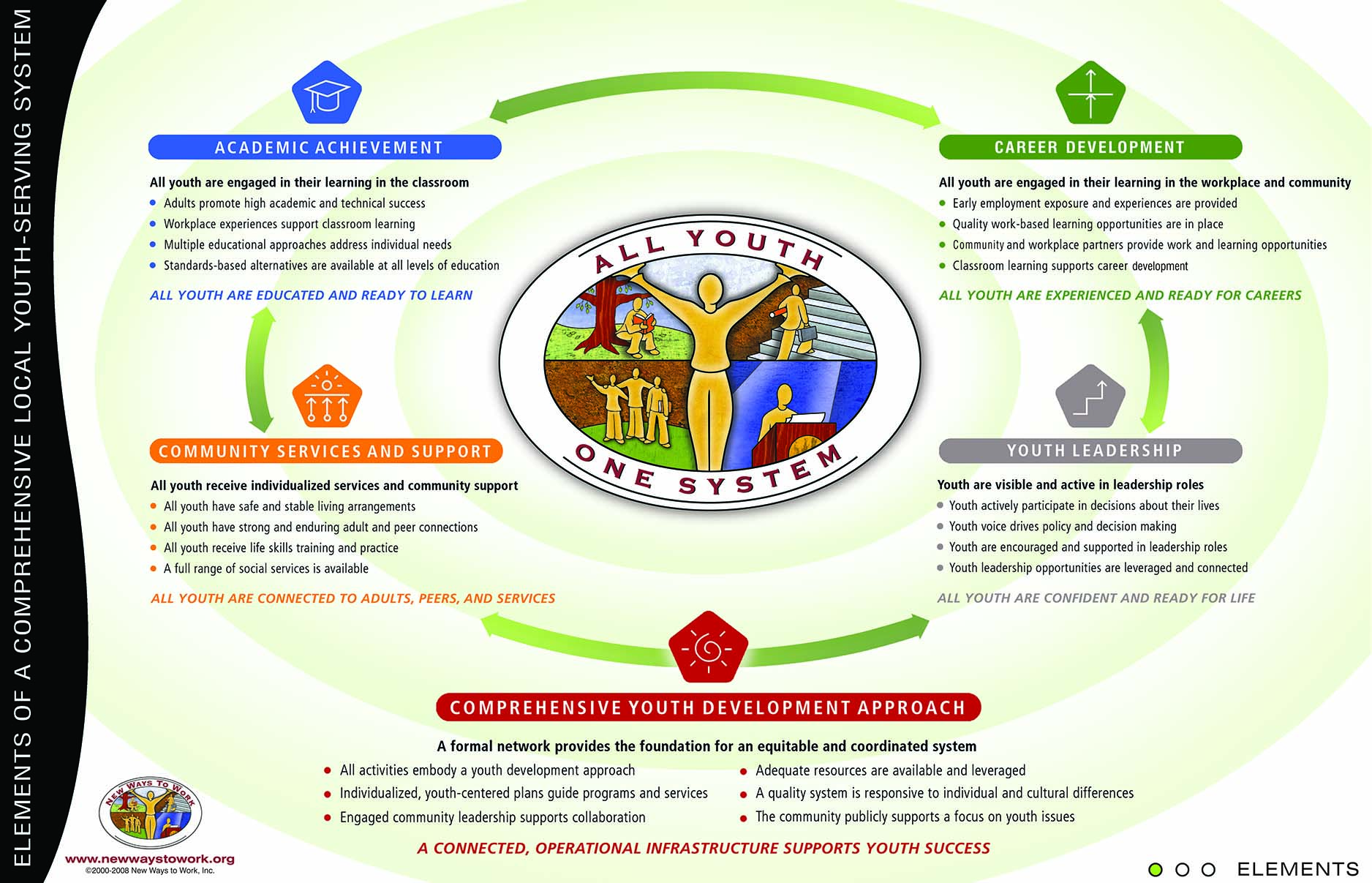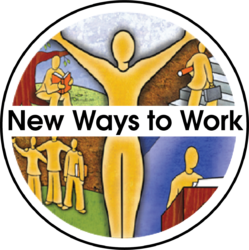All Youth-One System
Equity, accessibility and equality in resources and outcomes for all youth.
No matter the age, no matter the environment, all youth need the same things to successfully transition to life as adults. New Ways has created tools that can be tailored and customized for local organizations to help address a population’s distinct circumstances, based on a sound universal foundation.
New Ways to Work pioneered All Youth – One System ™, a comprehensive approach to education, job training and social service supports that equips youth with the tangible tools necessary to be active, engaged, effective members of the workforce and the community.

What Does a Comprehensive Local Youth-Serving System Look Like?
In a comprehensive and connected local youth system, programs, initiatives, and institutions work together to eliminate the duplication of services, maximize the impacts of multiple funding sources, and implement long-range plans to improve outcomes for the youth they serve. There is a systemic approach and infra-structure that supports access to and the engagement of employers and workplace partners, schools and training organizations, social services and community organizations, and families and neighborhoods to serve the needs of young people as they prepare for life as adults.
Four core Elements, illustrated in the chart above, need to be in place in order to provide a balanced set of services, support and opportunities to youth and ensure their success as they transition to adulthood. These four content elements are supported by a fifth: a community-wide structure and approach that ensures the coordination of a continuum of services across programs, institutions and projects, and delivers those programs and services through a youth development approach.
The Five Elements
Academic Achievement
All youth are engaged in their learning in the classroom and expected and supported to achieve high academic and career technical standards at all levels of the educational system.
Academic Achievement
In a comprehensive youth serving system, all youth are engaged in their learning in classrooms at all levels of our education and training systems. Teachers, faculty and other practitioners hold high expectations for the youth they serve and apply instructional strategies that address the learning styles of each individual student. Curriculum is designed to support standards-based academic achievement while also linking content to contextualized and relevant learning experiences that prepare youth for future educational and technical skills success. Programs and services support high academic standards and workplace and community experiences encourage academic excellence. Educators utilize a variety of strategies to support young people’s educational success, specifically tailoring approaches to address individual learning and developmental needs. When young people complete their education, whether at the high school or college level, they are prepared for success in their career and life, and understand the range of options before them.
The following characteristics describe a community that is successfully addressing the element of Academic Achievement:
All youth are engaged in their learning in the classroom
- Adults promote high academic and technical success
- Workplace experiences support classroom learning
- Multiple educational approaches address individual needs
- Standards-based alternatives are available at all levels of education
Result: All youth are educated and ready to learn
Career Development
All youth are provided learning opportunities and experiences in the workplace and community. They are exposed to a range of activities that further their career awareness, help them develop personal career goals, and build the skills they need to be successful in the future.
Career Development
In a comprehensive youth serving system, all youth are engaged in their learning in the workplace and community. Early and ongoing exposure to career and employment opportunities is provided to young people through their school and community-based programs. Youth participate in quality work-based activities that support what they are learning in the classroom, beginning as early as the elementary school level, and continuing throughout their high school and post-secondary experiences. Schools and community-based organizations have strong partnerships with government, local businesses, and other workplace partners, who provide relevant and meaningful work and learning experiences for young people. These experiences address individual needs and youth are prepared for and understand their career options.
The following characteristics describe a community that is successfully addressing the element of Career Development:
All youth are engaged in their learning in the workplace and community
- Early employment exposure and experiences are provided
- Quality work-based learning opportunities are in place
- Community and workplace partners provide work and learning opportunities
- Classroom learning supports career development
Result: All youth are experienced and ready for careers
Community Services and Support
All youth experience positive connections to caring adults and peers, and receive services in safe environments. Services and community supports target and address individualized needs.
Community Services and Support
In a comprehensive youth serving system, all youth receive individualized services and community support. All youth have safe and stable living arrangements, and are connected to caring adults who see to their physical, developmental and emotional needs. Youth experience strong and enduring peer relationships and connections to at least one adult who will support them throughout their lives. Young people are prepared for adulthood, having experienced and practiced the life skills necessary to live independently and have access to a full range of culturally competent social services and supports to address their needs.
The following characteristics describe a community that is successfully addressing the element of Community Services and Support:
All youth receive individualized services and community support
- All youth have safe and stable living arrangements
- All youth have strong and enduring adult and peer connections
- All youth receive life skills training and practice
- A full range of social services is available
Result: All youth are connected to adults, peers, and services
Youth Leadership
Youth are engaged and visibly active in leadership roles in the community and take an active role in designing and determining the activities and opportunities provided to them.
Youth Leadership
In a comprehensive youth-serving system, youth are visible and active in leadership roles. They participate in decisions about their lives and play active roles in designing their individual service strategies. They provide the voice that drives policy and decision making. Adults encourage and support youth in leadership roles within their organizations and institutions, and opportunities for youth leadership are leveraged within communities and connected to broader, systemic change. As a result, youth grow up confident and ready for life.
The following characteristics describe a community that is successfully addressing the element of Youth Leadership:
Youth are visible and active in leadership roles
- Youth actively participate in decisions about their lives
- Youth voice drives policy and decision making
- Youth are encouraged and supported in leadership roles
- Youth leadership opportunities are leveraged and connected
Result: All youth are confident and ready for life
Comprehensive Youth Development Approach
A formal, networked system of institutions, providers, and programs is in place and provides a comprehensive set of services and supports that support successful transitions for youth. Youth development principles of thriving, learning, working, connecting, and leading are infused throughout the system.
Comprehensive Youth Development Approach
In a comprehensive youth serving system, a formal network provides the foundation for an equitable and coordinated system that meets the needs of youth. Institutions and organizations that support young people apply a youth development approach in all their activities and services. Community leaders are engaged in efforts to support the lives of youth and promote effective collaboration between and among systems. Activities are intentionally sequenced and coordinated, resources are leveraged, and a connected operational infrastructure is in place.
The following characteristics describe a community that is successfully addressing the element of a Comprehensive Youth Development Approach:t:
A formal network provides the foundation for an equitable and coordinated system
- All activities embody a youth development approach
- Individualized, youth-centered plans guide programs and services
- Engaged community leadership supports collaboration
- Adequate resources are available and leveraged
- A quality system is responsive to individual and cultural differences
- The community publicly supports a focus on youth issues
Result: A connected, operational infrastructure supports youth success
